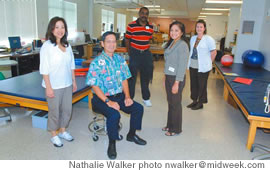Leading Through Teamwork
About two months ago, I accepted the position of full-time medical director at REHAB for the second time in 23 years. Quickly, through the coconut wireless, many colleagues discharged e-mails asking me: “Why?” And my reply was: “REHAB is valuable for Hawaii.”
REHAB is an important asset to our health care in Hawaii. It sets the standard of rehabilitation practice by which the medical field strives to fulfill REHAB’s mission of “rebuilding lives together.”
In fact, REHAB is the only full-service specialty hospital that provides inpatient and outpatient medical rehabilitation in the Pacific region. Its impact is not trivial. In 2006, more than 1,600 inpatients and 6,000 outpatients will be treated by physicians, nurses, therapists and psychologists at REHAB. For 2007 and beyond, the numbers should be greater.
Understanding the value of medical rehabilitation can be confusing, when it is defined by exotic pharmaceuticals, major operations and expensive cutting edge technology like MRI scanners or linear accelerators. Although the quality of medical and surgical care surely influences long-term outcomes, REHAB’s patients have one thing in common - the impact of injury or disease on the quality of their lives.
The impact results from injuries or diseases to the brain, spinal cord, nerves and musculoskeletal system. REHAB treats patients with stroke, brain and spinal cord trauma, amputations, complicated orthopedic cases and other neurologic diagnoses. In its seven clinics, REHAB sees patients disabled by these and other conditions such as painful necks, backs and joints. The clinical team treats patients to help them regain safe and independent levels of mobility, self-care, swallowing, toileting and communication for living at home.

Taking a break in the REHAB physical therapy room
(from left): Stephanie Matsunaka, Gary Okamoto,
Jerry Wheeler, Lorna Ancheta and Audrey Torres
Although the mission of REHAB endures, the economic tsunami of the U.S. health care crisis has posed a different set of challenges to REHAB’s medical direction. During my first tenure from 1983 to 1992, I concentrated on acquiring the latest affordable technology in medical rehabilitation. Health care financing fueled the pace of technical innovation and scientific knowledge and, at REHAB, unprecedented capital expansion. My role then was to bring these clinical advances to patients through well-trained rehabilitation personnel.
On the eve of 2007, a different set of circumstances surround REHAB.
Fewer physiatrists or physicians specialized in medical rehabilitation are interested in making a career out of hospital practice. Highly skilled rehabilitation professionals like nurses and physical therapists are in short supply. Impending Medicare cuts, low Medicaid payments, and restrictive private health plan benefits hang over the future of all rehabilitation facilities.
The challenge of medical direction is how to continue the fundamental approach to a “high touch, low tech” service within this current environment. During this tenure, my emphasis is on team-work, which means building high-performance teams that optimize the latest clinical advances for the most cost-effective outcomes.
REHAB as a health care organization strives to be the first choice of medical rehabilitation for physicians and their patients in Hawaii.
As my baby boomer friends remind me, REHAB needs to be ready as their first choice.
Next Week: Malcom Tajiri, Senior Vice President of Servco Insurance
E-mail this story | Print this page | Comments (0) | Archive | RSS Comments (0) |
Most Recent Comment(s):




 Del.icio.us
Del.icio.us








